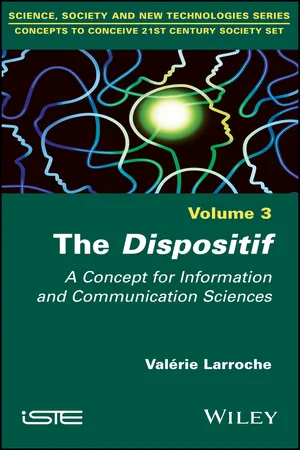We focus in this chapter on the technical aspect of a dispositive. This is why we have chosen to talk about its characteristics for a researcher–engineer, for whom “the technical issue comes down, in essence, to the dispositive issue”6 (Bachimont, 2004, p. 16)7. Timelines, the reproducibility of technical activities and their efficiency within a dispositive will be successively discussed.
1.1.1. Timelines within dispositives
To begin with, the first characteristic we wish to develop relates to timelines8 linked to a dispositive. The latter is defined as “a practical and spatial organizationable to produce and determine a future”9 (Bachimont, 2004, p. 16). This definition is linked to designers’ vision of the dispositive.
For this definition, the timeline is a defining feature of the dispositive whose function is “to convert a relationship with time into a relationship with space. Technique is, at this level, a de-temporalization of the future in order to spatialize it”10 (Bachimont, 2004, p. 18). To characterize this idea of space allocated to the dispositive, we borrow from Michel de Certeau11 his distinction between location and space. A location has an instantaneous configuration at a given time, where two elements are necessarily in well-defined positions. Space, on the other hand, takes into account the movement unfolding there, and Michel de Certeau (1990) refers to it as the “practiced location” (p. 173). The example of the street perfectly illustrates this distinction. The street becomes space because of walkers, while a street is geometrically defined by urban planners. By extension, it can be said that it is only during a theatrical performance that a theater becomes a space where the public and the actors act. Space, for Michel de Certeau (1990), integrates “the effect produced by the operations directing it, detailing it, temporalizing it, and leading it to function as versatile units of conflicting programs or contractual proximities”12 (p. 173). The street becomes space when the walker, the demonstrator, the seller, etc., occupy it. The dispositive, on the other hand, is defined as space, when users act to benefit from the service or to make it work, thus participating in a collective set where actions follow one another.
In the dispositive, the future becomes a modality of the present or, in other words, “the present makes the future available”13 (Bachimont, 2004, p. 18). A dispositive considers a depth of time, especially linked to the useful time to perform actions or facilitate the sequence of events. It models flows, since successive operations can be considered. The dispositive then reconciles the spatial and time dimensions. It is a space of possible futures. The dispositive is not just a simple arrangement observed at a given time, but an organized space where actions take place. An organization will be considered as a dispositive when it is animated by technical actions performed by machines or humans while respecting a sequence. In other words, actions influence and shape the dispositive. “The dispositive does not have the purity of structures14: its form is only the arrangement determined in space and time within which flows (forces) processed by it are balanced and stabilized”15 (Vouilloux, 2007, p. 157)16. Bernard Vouilloux17 illustrates this idea of flow within the dispositive when it justifies the success of the theatrical model in the criticism of dispositives:
In this quote, Bernard Vouilloux explains that the dispositive transforms the arrangement in space (here the décor, light, sound, etc.) when the play takes place and, more generally, when the action or event is effective within the dispositive.
The arrangement of the dispositive offers a potential and modalities for actions. We will be able to talk about a genuine dispositive when the latter is animated by the effect of the actions performed by humans and technical objects.
For Brigitte Albero19, who defines dispositives in the training sector, timelines are varied and strained. There are, of course, those of the actors – in her context, trainers and learners – who must deal with the contingencies linked to their activity and who modernize the dispositive. She adds to it “the time axis of the designers’ past experience, which led to the creation of the dispositive, as well as the projections and expectations directing its trajectory”20 (Albero, 2010, p. ...
